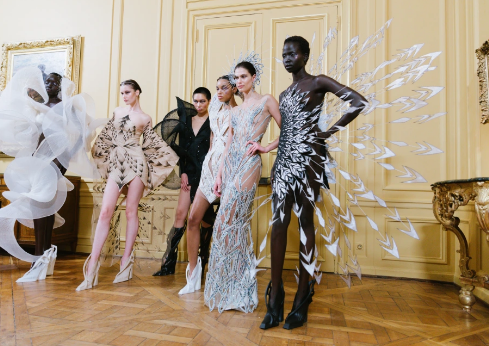Haute Couture, a term synonymous with luxury and exclusivity, has a rich and storied history that spans centuries. Originating in Paris, the capital of fashion, haute couture represents the pinnacle of craftsmanship, creativity, and sartorial excellence. From its humble beginnings in the 19th century to its current status as a global symbol of prestige, the evolution of haute couture reflects the shifting landscapes of fashion, society, and culture.
The Birth of Haute Couture:
The roots of haute couture can be traced back to the mid-19th century when Charles Frederick Worth, an English-born designer, established the first haute couture house in Paris. Worth’s visionary approach revolutionized the fashion industry by introducing the concept of designing and creating garments for specific clients, rather than adhering to mass production.
Worth’s atelier attracted the elite of European society, including royalty and aristocrats, who sought his exquisite creations tailored to their individual tastes and measurements. Through meticulous craftsmanship and attention to detail, Worth elevated dressmaking to an art form, laying the foundation for the haute couture tradition.
The Golden Age of Haute Couture:
The early 20th century marked the golden age of haute couture, characterized by the emergence of legendary designers such as Coco Chanel, Christian Dior, and Elsa Schiaparelli. These visionaries redefined fashion with their innovative designs, setting the standard for elegance, sophistication, and glamour.
Chanel, with her revolutionary approach to women’s fashion, introduced the concept of casual chic and liberated women from the constraints of corsets and rigid silhouettes. Dior’s New Look, unveiled in 1947, epitomized post-war optimism with its voluminous skirts and nipped-in waists, signaling a return to opulence and femininity.
Meanwhile, Schiaparelli’s avant-garde creations blurred the boundaries between fashion and art, incorporating surrealistic elements and bold colors into her designs. Together, these designers propelled Paris to the forefront of the global fashion scene, cementing its reputation as the capital of haute couture.
The Globalization of Haute Couture:
As the 20th century progressed, haute couture underwent significant transformations in response to shifting societal norms and technological advancements. The rise of ready-to-wear clothing and the advent of mass production posed challenges to the traditional haute couture model, prompting designers to adapt to changing consumer demands.
However, rather than fading into obscurity, haute couture evolved to embrace new opportunities in the global market. Luxury brands such as Chanel, Dior, and Givenchy expanded their reach beyond Paris, opening boutiques in major cities worldwide and catering to an increasingly diverse clientele.
Furthermore, advancements in communication and media technology facilitated the dissemination of haute couture imagery to a global audience, fueling fascination and desire for high-end fashion. Fashion shows became extravagant spectacles, with designers showcasing their collections on elaborate runways and inviting celebrities and influencers to front row seats.
The Digital Age and Haute Couture:
In the 21st century, the digital revolution has revolutionized the way haute couture is produced, marketed, and consumed. Social media platforms such as Instagram and Twitter have become indispensable tools for fashion houses to engage with consumers, generate buzz around new collections, and showcase behind-the-scenes glimpses of the creative process.
Moreover, e-commerce has democratized access to haute couture, allowing enthusiasts from around the world to purchase luxury garments online and participate in the haute couture experience. Virtual fashion shows and digital presentations have emerged as alternatives to traditional runway shows, offering immersive experiences that transcend geographical boundaries.
Despite these innovations, haute couture remains a symbol of exclusivity and craftsmanship, with designers continuing to uphold the tradition of creating bespoke garments of the highest quality. While the fashion industry continues to evolve at a rapid pace, the allure of haute couture endures, reminding us of the timeless elegance and artistry that define luxury fashion.
Conclusion:
The history of haute couture is a testament to the enduring allure of craftsmanship, creativity, and luxury. From its origins in the ateliers of Paris to its global prominence today, haute couture has captivated generations with its exquisite designs and unparalleled craftsmanship.
As we look to the future, haute couture will undoubtedly continue to evolve in response to changing tastes, technologies, and cultural influences. Yet, amidst the flux of the fashion industry, the essence of haute couture—its commitment to excellence and innovation—remains unchanged, ensuring its enduring legacy for generations to come.
